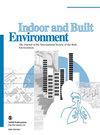基于长期监测的北方燃煤农村居民楼室内空气质量调查
IF 2.9
3区 工程技术
Q2 CONSTRUCTION & BUILDING TECHNOLOGY
引用次数: 0
摘要
室内空气质量(IAQ)与居民健康密切相关,一直受到学术界和政府监管机构的广泛关注。然而,对农村建筑采暖期间室内居住时间较长的室内空气质量进行定量研究的研究较少。本研究在采暖季(120天中的15天)对中国北方20户农村住宅的室内空气参数(温度、CO2、甲醛和PM2.5)进行了监测和定量分析。定量分析各室内空气质量参数后,采用Pearson相关模型评价各参数之间的关系。结果表明,只有4户家庭在采暖期50%以上的时间内室内温度保持在18℃以上。另外,有7户、2户和18户,其中CO2、甲醛和PM2.5超标时间占比超过40%。室内PM2.5浓度大部分时间高于室外。因此,室内PM2.5主要是由室内活动引起的,而不是由室外输送的。相关分析显示,16户和12户的CO2与甲醛和PM2.5呈正相关。本文章由计算机程序翻译,如有差异,请以英文原文为准。
Investigation of indoor air quality in coal-heating rural residential buildings in Northern China based on longtime monitoring
Indoor air quality (IAQ) is closely related to resident health and has been drawing extensive consideration from academics as well as government regulators. However, few studies have quantitatively investigated IAQ in rural buildings during the heating period, in which the resident time indoors is relatively longer. This study has monitored and quantitatively analyzed the indoor air parameters (temperature, CO2, formaldehyde and PM2.5) of 20 rural houses in Northern China during the heating season (15 days out of 120). After quantitatively analyzing the IAQ parameters, the Pearson correlation model was also adopted to evaluate the relationships between them. Results showed that only 4 households could keep the indoor temperature above 18°C for more than 50% of the heating period. Additionally, there were 7, 2 and 18 households, of which the over-standard time of CO2, formaldehyde and PM2.5 took up more than 40%. The concentration of indoor PM2.5 was higher than outdoors most of the time. Therefore, indoor PM2.5 was mainly caused by indoor activities rather than transported from outside. Correlation analysis showed that CO2 was positively correlated with formaldehyde and PM2.5 in 16 and 12 households.
求助全文
通过发布文献求助,成功后即可免费获取论文全文。
去求助
来源期刊

Indoor and Built Environment
环境科学-工程:环境
CiteScore
6.40
自引率
25.00%
发文量
130
审稿时长
2.6 months
期刊介绍:
Indoor and Built Environment publishes reports on any topic pertaining to the quality of the indoor and built environment, and how these might effect the health, performance, efficiency and comfort of persons living or working there. Topics range from urban infrastructure, design of buildings, and materials used to laboratory studies including building airflow simulations and health effects. This journal is a member of the Committee on Publication Ethics (COPE).
 求助内容:
求助内容: 应助结果提醒方式:
应助结果提醒方式:


